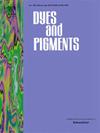基于咔唑-嘧啶-苯衍生物的单组分双发射白色余辉
IF 4.1
3区 工程技术
Q2 CHEMISTRY, APPLIED
引用次数: 0
摘要
由于难以同时支持不同激发态的长寿命发射并获得互补的发射颜色,因此实现单组分有机白色余辉材料仍然是一项巨大的挑战。在此,我们提出了一个双发射模型,即单重激发态和三重激发态的辐射衰变可产生白色余辉。基于构建的咔唑-嘧啶-苯(CPB)构件,CPB-H、CPB-MeO 和 CPB-F 在室温下成功实现了白色余辉。尤其是 CPB-H,其白色余辉的寿命约为 0.3 秒。双发射主要取决于所设计分子的电子结构,其中单态和三态之间的适当能级匹配对于单体或堆叠二聚体中的 ISC 过程以及其他单体或二聚体中的 RISC 过程都是必要的。本文章由计算机程序翻译,如有差异,请以英文原文为准。
Single-component white afterglow from dual emission based on carbazole-pyrimidine-benzene derivatives
Achieving single-component organic white afterglow material remains a great challenge owing to the difficulties in simultaneously supporting long-lived emissions from varied excited states and getting complementary emission color. Here, a dual emission model that the radiative decays from singlet and triplet excited states was proposed to afford white afterglow. Based on the constructed carbazole-pyrimidine-benzene (CPB) building block, white afterglow was successfully achieved by CPB-H, CPB-MeO, and CPB-F at room temperature. Especially, CPB-H exhibits white afterglow with a lifetime about 0.3 s. The white afterglow was realized by dual emissions including blue TADF and yellow phosphorescence emission. The dual emissions are mainly dependent on the electronic structures of designed molecules, where the appropriate energy level matching between singlet and triplet states are necessary for ISC process in monomer or stacked dimer and for RISC process in other monomer or dimer.
求助全文
通过发布文献求助,成功后即可免费获取论文全文。
去求助
来源期刊

Dyes and Pigments
工程技术-材料科学:纺织
CiteScore
8.20
自引率
13.30%
发文量
933
审稿时长
33 days
期刊介绍:
Dyes and Pigments covers the scientific and technical aspects of the chemistry and physics of dyes, pigments and their intermediates. Emphasis is placed on the properties of the colouring matters themselves rather than on their applications or the system in which they may be applied.
Thus the journal accepts research and review papers on the synthesis of dyes, pigments and intermediates, their physical or chemical properties, e.g. spectroscopic, surface, solution or solid state characteristics, the physical aspects of their preparation, e.g. precipitation, nucleation and growth, crystal formation, liquid crystalline characteristics, their photochemical, ecological or biological properties and the relationship between colour and chemical constitution. However, papers are considered which deal with the more fundamental aspects of colourant application and of the interactions of colourants with substrates or media.
The journal will interest a wide variety of workers in a range of disciplines whose work involves dyes, pigments and their intermediates, and provides a platform for investigators with common interests but diverse fields of activity such as cosmetics, reprographics, dye and pigment synthesis, medical research, polymers, etc.
 求助内容:
求助内容: 应助结果提醒方式:
应助结果提醒方式:


